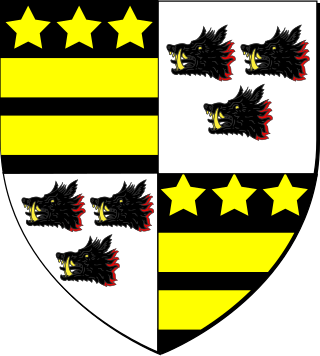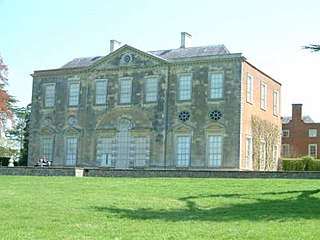Related Research Articles

Baron Carbery, of Carbery in the County of Cork, is a title in the Peerage of Ireland. It was created in 1715 for George Evans, with remainder to the heirs male of his father and namesake George Evans, a supporter of William and Mary during the Glorious Revolution, who had earlier declined the offer of a peerage. After his elevation to the peerage, Lord Carbery represented Westbury in the House of Commons. He was succeeded by his eldest son, the second Baron. He also sat as Member of Parliament for Westbury. His grandson, the fourth Baron, briefly represented Rutland in Parliament. He was succeeded by his uncle, the fifth Baron. On his death, the line of the eldest son of the first Baron failed. He was succeeded by his first cousin once removed, the sixth Baron, who had previously succeeded his father as second Baronet, of Castle Freke. Lord Carbery sat in the House of Lords as an Irish Representative Peer from 1824 to 1845. His nephew, the eighth Baron, was an Irish Representative Peer from 1891 to 1894. As of 2014 the titles are held by the latter's great-great-grandson, the twelfth Baron, who succeeded his father in 2012.
Baron Leighton of St Mellons, of St Mellons in the County of Monmouth, is a title in the Peerage of the United Kingdom. It was created on 25 January 1962 for the Welsh shipping magnate Sir Leighton Seager, 1st Baronet. He was the son of Sir William Henry Seager. Seager had already been created a Baronet, of St Mellons in the County of Monmouth on 1 July 1952. As of 2017 the titles are held by his grandson, the third Baron, who succeeded his father in 1998. As of 31 December 2016 the present Baronet has not successfully proven his succession and is therefore not on the Official Roll of the Baronetage, with the baronetcy considered dormant since 1998.

Sir Simon Neville Llewelyn Marsden, 4th Baronet was an English photographer and author. He is known best for his uncommon black-and-white photographs of allegedly haunted houses and places throughout Europe. He succeeded his brother as baronet of Grimsby in Lincolnshire in 1997.

There have been three baronetcies held by persons with the surname Verney, one in the Baronetage of England and two in the Baronetage of the United Kingdom. Two of the creations are extant as of 2016.
There have been three baronetcies created for persons with the surname Harvey, all in the Baronetage of the United Kingdom.

There have been twelve baronetcies created for people with the surname Scott, one in the Baronetage of England, two in the Baronetage of Nova Scotia, and nine in the Baronetage of the United Kingdom.
There have been three baronetcies created for members of the Shelley family, one in the Baronetage of England and two in the Baronetage of the United Kingdom. The three recipients of the titles represented two different branches of the family with a common ancestor in John Shelley of Michelgrove. The most famous member of the family is the poet Percy Bysshe Shelley, although he never held any title. The holders of the third and last creation were later elevated to the peerage as Baron De L'Isle and Dudley and Viscount De L'Isle.
There have been two baronetcies created for persons with the surname MacLeod, both in the Baronetage of the United Kingdom. As of 2014 both titles are extant.
The Debenham Baronetcy, of Bladen in the County of Dorset, is a title in the Baronetage of the United Kingdom. It was created on 28 January 1931 for Ernest Debenham, Chairman of Debenhams Ltd.
There have been nine baronetcies created for persons with the surname Moore, two in the Baronetage of England, one in the Baronetage of Ireland, two in the Baronetage of Great Britain and four in the Baronetage of the United Kingdom. As of 2014 two creations are extant and one is considered dormant.
There have been eight baronetcies created for persons with the surname Graham, two in the Baronetage of Nova Scotia, two in the Baronetage of England, one in the Baronetage of Great Britain and three in the Baronetage of the United Kingdom.
There have been eight baronetcies created for persons with the surname Jackson, one in the Baronetage of England, one in the Baronetage of Great Britain and six in the Baronetage of the United Kingdom. As of 2014 four of the creations are extant.
There have been two baronetcies created for persons with the surname Crossley, both in the Baronetage of the United Kingdom.
There have been three baronetcies created for persons with the surname Power, all in the Baronetage of the United Kingdom.
There have been four baronetcies created for persons with the surname Morris, all in the Baronetage of the United Kingdom. As of 2014 two of the creations are extant.

The Synge Baronetcy, of Kiltrough in the County of Meath, is a title in the Baronetage of the United Kingdom. It was created on 12 August 1801 for Robert Synge. The third Baronet served as High Sheriff of County Cork in 1844. The family surname is pronounced "Sing". As of 28 February 2014 the present Baronet has not successfully proven his succession and is therefore not on the Official Roll of the Baronetage, with the baronetcy considered dormant since 2011.

The Leeds Baronetcy, of Croxton Park in the County of Cambridge, is a title in the Baronetage of the United Kingdom. It was created on 31 December 1812 for George Leeds. He was an equerry to Prince Augustus Frederick, Duke of Sussex. The Croxton Park estate in Cambridgeshire had been in the Leeds family since circa 1568. As of 2011 the presumed ninth and present Baronet, a resident of Canada, has not successfully proven his succession and is not on the Official Roll of the Baronetage.
There have been four baronetcies created for members of the Thorold family of Lincolnshire, two in the Baronetage of England and two in the Baronetage of Great Britain. As of 2014 one creation is extant.
There have been three baronetcies created for personswith the surname Elphinstone, two in the Baronetage of Nova Scotia and one in the Baronetage of the United Kingdom. As of 2008 two of the creations are extant while one is dormant.

There have been five baronetcies created for persons with the surname Kennedy, one in the Baronetage of Ireland, three in the Baronetage of Nova Scotia and one in the Baronetage of the United Kingdom. One creation is extant as of 2010.
References
- Kidd, Charles, Williamson, David (editors). Debrett's Peerage and Baronetage (1990 edition). New York: St Martin's Press, 1990.
- Leigh Rayment's list of baronets